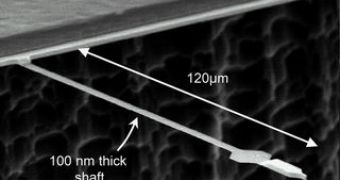Magnetic resonance imaging (MRI), formerly referred to as magnetic resonance tomography (MRT) or, in chemistry, nuclear magnetic resonance (NMR), is a non-invasive method used to render images of the inside of an object. It is primarily used in medical imaging to demonstrate pathological or other physiological alterations of living tissues. MRI also has uses outside the medical field, such as detecting rock permeability to hydrocarbons and as a non-destructive testing method to characterize the quality of products such as produce and timber.
IBM announced a breakthrough in nanoscale visualization technology that could lead to more powerful drugs and integrated circuits. Researchers at Almaden Research Center have found a way to use magnetic resonance imaging, or MRI, techniques to see nanoscale objects.
Dan Rugar, manager of nanoscale studies at the research center, said the discovery represents "a milestone that has shown that the principles of MRI can be married with scanning microscopy."
While the eventual goal - building a microscope than can see individual atoms in three dimensions - remains "a number of years away," Rugar said that extending MRI technology into the nanoscale realm is a significant achievement.
MRI, Rugar said, "is a great technology but it has always had one important limitation: It's not very sensitive." What IBM researchers have managed to do is use Magnetic Resonance Force Microscopy to image objects as small as 90 nanometers in two dimensions. A nanometer is a unit of measurement equal to one billionth of a meter.
With the future development of atomic scale 3-D imaging techniques, future applications based on this achievement could eventually have major impact on the study of materials - ranging from proteins and pharmaceuticals to integrated circuits - for which a detailed understanding of the atomic structure is essential. Knowing the exact location of specific atoms within tiny nanoelectronic structures, for example, would enhance designers' insight into manufacture and performance. The ability to directly image the detailed atomic structure of proteins would aid the development of new drugs.
IBM researchers have a long history of imaging breakthroughs. Gerd Binnig and Heinrich Rohrer of IBM's Zurich Research Laboratory won the 1986 Nobel Prize in Physics for inventing the scanning tunneling microscope.

 14 DAY TRIAL //
14 DAY TRIAL //